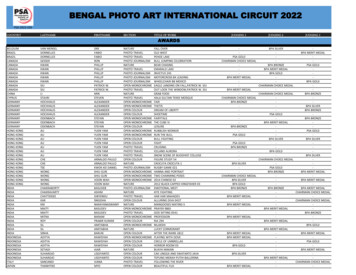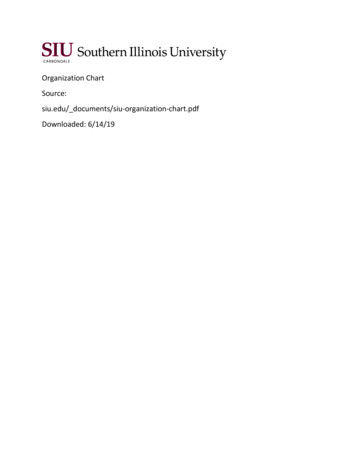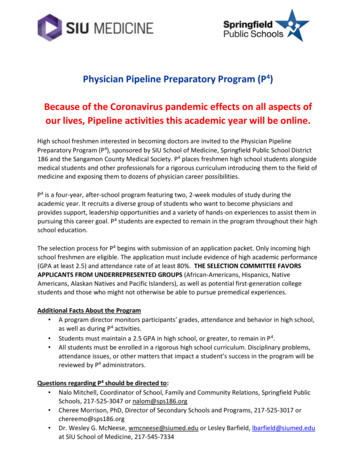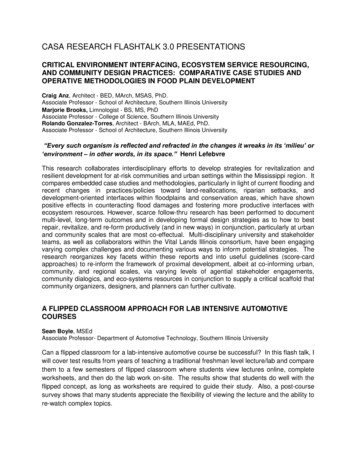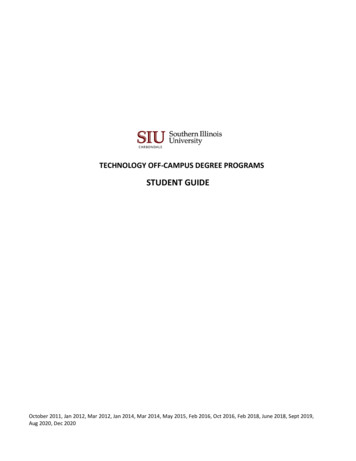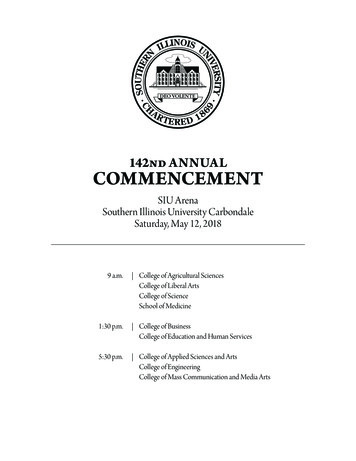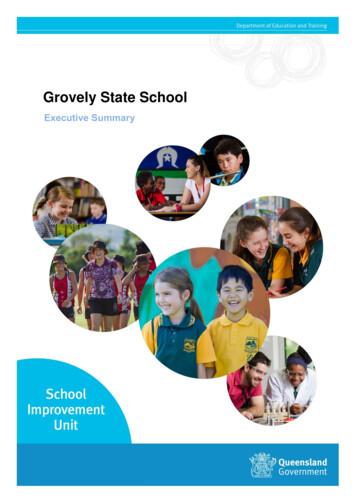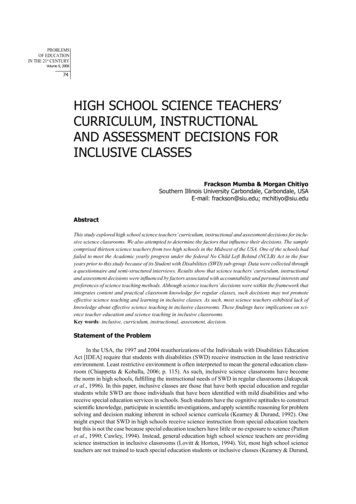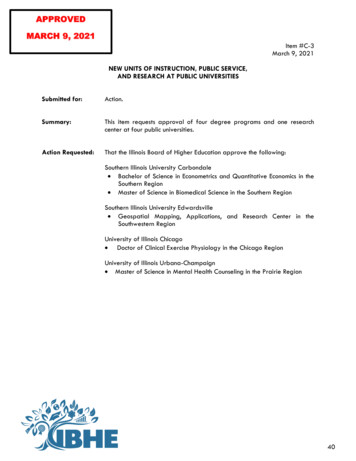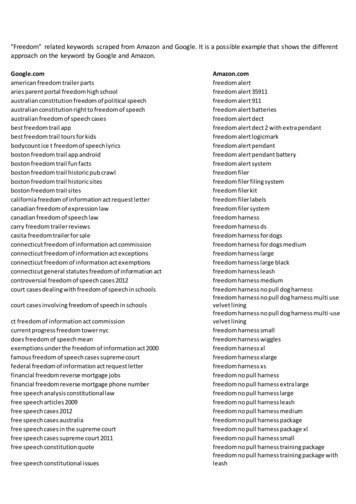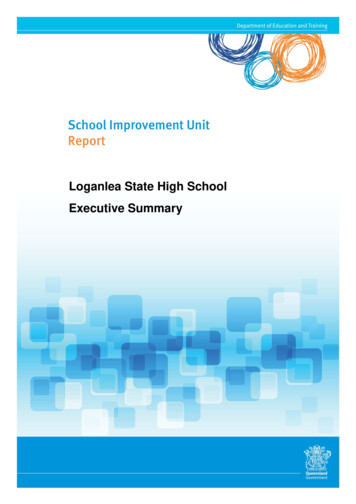
Transcription
Loganlea State High SchoolExecutive Summary
1. Introduction1.1 BackgroundThis report is a product of a review carried out at Loganlea State High School from 14 to16 March 2016. It provides an evaluation of the school’s performance against the ninedomains of the National School Improvement Tool. It also recommends improvementstrategies for the school to consider in consultation with its regional office and schoolcommunity.The review and report were completed by a review team from the School ImprovementUnit (SIU). For more information about the SIU and the new reviews for Queensland stateschools please visit the Department of Education and Training (DET) website.1.2 School context2Location:Neridah Street, LoganleaEducation region:South East RegionThe school opened in:1981Year levels:Year 7 to Year 12Current school enrolment:615Indigenous enrolments:10 per centStudents with disabilityenrolments:16 per centIndex of Community SocioEducational Advantage(ICSEA) value:929Year principal appointed:2010Number of teachers:57.18 (full-time equivalent)Nearby schools:Waterford West State School, Waterford State School, MarsdenState School, Kingston State School, Edens Landing SS, MarsdenState High School, Kingston College, Beenleigh State High School.Significant communitypartnerships:ENABLE Secondary School Alliance, LEA (Logan EducationAlliance), Stronger Smarter Institute Alumni School, AIME, GatewaySchool of Excellence in Agribusiness, Logan City Council,Loganlea Youth Development Program (LYDP) with Kirra Surf LifeSaving Club, BEACON Alumni School, Griffith Unireach, Universityof Southern Queensland (USQ), University of Queensland (UQ),Australian Business Community Network (ABCN), Goals andAspirations programs and the Logan Junior Chamber of Commerce.
Unique school programs:3LYDP – Loganlea Youth Development Program (LYDP), Camp FireDreaming Restaurant (TTC), Agribusiness – Gateway School ofExcellence, Munchkins Playgroup (Early Childhood), ConnectionsServices, Knowledge House Centre For Excellence in IndigenousEducation, Sister School program with Tsz-Shiou School in Taiwan,Technology Partnership – building 3D printers
1.3 Review methodologyThe review was conducted by a team of three reviewers.The review consisted of: a pre-review audit of the school’s performance data and other school information consultation with the school’s Assistant Regional Director, Ms Karen Lindsay a school visit of three days interviews with staff members, students, parents and community representatives,including:oPrincipal and two deputy principalsoEight Heads of Department (HOD), Head of Special Education Services(HOSES), master teacher, success coach, pedagogy coach – numeracy,Head of Curriculum (HOC)o22 teachers and three support staffoBusiness Services Manager (BSM), four administration staff and anagriculture assistanceo18 student leaders and 60 other studentsoParents and Citizens’ Association (P&C) president and four other parentand/or community membersoTwo principals of partner schooloGuidance officer, youth support coordinator and school-based policeofficer1.4 Review team4Denise KostowskiInternal reviewer, SIU (review chair)Ken GreenInternal reviewer, SIURaelene FyshExternal reviewer
2. Executive summary2.1 Key findings The staff of the school value positive and caring relationships to promote successfullearning.The school has an attractive, expansive and stimulating physical environment. Theschool takes pride that they accept, support and encourage learning for their studentswho come to the school from a diverse range of backgrounds and cultures. The school leaders and staff members view reliable and timely data as essential tothe school’s improvement agenda.A high priority is given to the collection of a range of student outcomes data. A dataplan exists. The school staff members use a wide variety of data to develop programs,allocate students into differentiated learning groups, to inform practice and measuresuccess. Staff, students and parents identify the lack of engagement of some students as asignificant challenge to teaching and learning.The school has a current Responsible Behaviour Plan for Students (RBPS) whicharticulates high expectations of students’ behaviour. The high turnover of staff hasresulted in the inconsistent focus on high expectations to maintain a learningenvironment that is safe, respectful, tolerant and promoting intellectual rigour. Improved attendance is seen as a priority for student improvement.The school has allocated resources to this priority. Roles exist for supportingattendance processes within the school, including the deployment of an attendanceofficer. Strategies for improvement are not linked to the specific roles andaccountabilities clearly articulated in an attendance plan. The school leadership group has developed a broad agenda for improvement which isdocumented in the Annual Improvement Plan (AIP) 2016.The three key priorities detailed are: Learning excellence – A-E outcomes;Pedagogical excellence – quality teaching through collaborative learning, andMaximise Year 12 outcomes with successful transition to post-secondary education,training and employment.5
The school has espoused Pedagogical excellence - quality teaching as a keyimprovement priority.The AIP includes a number of actions that refer to teaching programs to be deliveredin the school such as MultiLIT, Accelerated Reader Program, Question AnswerRelationship (QAR), SIMPA, Reciprocal Reading and Marzano’s1 Six Steps toTeaching. There is a school professional development plan. Whilst a range ofprofessional development opportunities are offered internally to align with the schoolpriorities, the professional learning plan does not include a strategic schedule for whatis offered to staff and when it is provided. Staff at all levels have expressed that they value receiving timely and quality feedback.The school has a line management structure involving the practice of regularlyscheduled meetings. The focus of these meetings is loosely based on the currentimprovement agenda. With the exception of those specifically employed as a coach ormentor, members of the leadership team have not undertaken recent professionallearning to develop their mentoring/coaching skills.1Marzano, R.J. (2007). The Art and Science of Teaching: A comprehensive framework foreffective instruction. ASCD, Alexandria, VA.6
2.2 Key improvement strategies Research and visit like-schools who have successfully embedded a safe, respectful,tolerant learning environment with a view to engaging staff members to effectively andconsistently implement the school’s RBPS. Research effective practices to develop and embed a strategic attendance policy withclear procedures, roles, accountabilities, targets and timelines. Rationalise the improvement agenda to be sharp, narrow and deep to focus the wholeschool’s attention on the core learning priorities. Review the school’s processes tomonitor the implementation of the improvement strategies to ensure that all membersof the leadership team are driving the agenda and have clear accountabilities fortargets and implementation timelines. Develop a coherent professional development plan, which explicitly articulates topicsand time frames for the delivery of professional development to staff aligned to thecore school priorities and pedagogical framework. Include in the plan the inductionand probationary teacher programs. Upskill the leadership team to develop a shared understanding of processes andprotocols for focussed coaching and mentoring of staff in the school to drive theimprovement agenda.7
Unit (SIU). For more information about the SIU and the new reviews for Queensland state schools please visit the Department of Education and Training (DET) website . 1.2 School context Location: Neridah Street, Loganlea Education region: South East Region The school opened in: 1981 Year levels: Year 7 to Year 12
